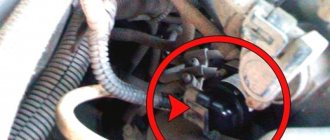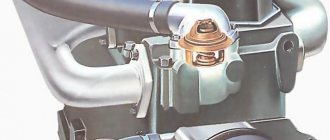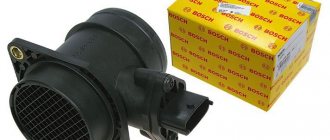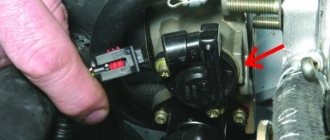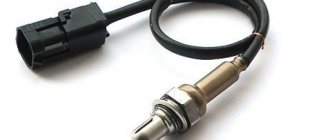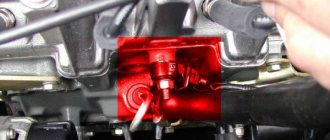Cars in Russia are now equipped with a variety of electronic control devices. In this sense, the VAZ-2115 is no exception - it is equipped with various sensors. What are their purposes and possible malfunctions are described in this article.
If any problem occurs in the engine, an alarm light immediately lights up on the instrument panel in the cabin. In a situation where the malfunction is minor, it goes out approximately a second after the power unit starts. This is approximately the amount of time it takes for the on-board computer to carry out diagnostics.
If the breakdown is serious enough, the ECU signals this by issuing certain error codes. So:
- 2 means that problems have arisen with the fuel level sensor;
- 13 – no information on air quality;
- 14-15 – antifreeze level is not controlled;
- 19 – incorrect readings from the crankshaft sensor;
- 21-22 – problems with the throttle valve;
- 23-25 – the device recording the air temperature has failed;
- 24 – speed meter does not work;
- 33-34 – problems with the mass air flow sensor;
- 35 – idle speed control is knocked down;
- 43 – failure of the knock sensor;
- 61 – data is not supplied from the device that measures the oxygen level.
Knowing the codes allows you to quickly resolve problems.
Sensor panel VAZ 2115
The VAZ 2115 sensor panel includes the following devices:
- Speedometer. Shows the driver the current speed of the vehicle. The speedometer receives information about the vehicle's speed thanks to a sensor located on the gearbox.
- Tachometer. Located to the left of the speedometer. It is an electronic device that receives signals from the BC and reflects the current crankshaft speed.
- Fuel level indicator. Located to the right of the speedometer. Shows the amount of fuel in the tank.
- Coolant level indicator. Reports the coolant temperature. The pointer is located to the left of the tachometer. The information comes from the corresponding sensor.
How to determine if the engine is overheated
At first glance it seems very simple - according to the indicators of the engine temperature device, or - sensor. This is true, if not for one thing - novice motorists are so captivated by the road situation around them that they look at the instrument panel only in one case - how much fuel is left. Experienced motorists, on the contrary, due to their confidence in their abilities, also do not look at the car’s dashboard. And as a result, a situation often arises that overheating is detected when the engine temperature has long exceeded permissible limits, and irreparable damage has been caused to the engine. It is irreparable overheating that is one of the most complex malfunctions, which leads to very serious consequences. But more on that later.
But there is a way that will not let you miss the moment of overheating. This is problematic in a traffic jam, and is not always clearly present, but here’s what you should be aware of:
— As soon as the engine temperature exceeds the permissible norm, when you sharply press the gas pedal, or when accelerating the car, even slightly, detonation knocks can be clearly heard
, which are popularly called “tapping fingers.” This is not true, but everyone knows this definition.
If you hear such a sound, there is a 99% chance that the engine has overheated, and action must be taken.
Detonation knock is a loud metallic knock, the frequency of which coincides with the engine speed. You've probably heard such sounds when refueling with low-quality fuel. I personally don’t know where the concept of “tapping fingers” came from. But the real reason for such knocking noises is a disruption in the fuel combustion process. What you hear is nothing more than explosions of the fuel mixture. During normal engine operation, the combustion process is controlled, but as soon as one of the operating parameters is violated, the process goes out of control and combustion turns into an explosion. Hence the concept - detonation (from the word detonate - explode) knocks. When the engine overheats, this is the first sign.
Before continuing the conversation, let's define what is normal temperature and what is overheating. There is no one-word answer, but there are general rules.
The engine temperature is within 85-95 degrees Celsius, which is working.
Engine temperature up to 100 degrees is acceptable. This means that a short-term increase in temperature to 100, sometimes up to 105 degrees is allowed. Just for a short time - up to 5 minutes.
Engine temperature above 105 degrees Celsius means overheating and action must be taken.
VAZ 2115 sensor diagram
The sensors on the VAZ 2115 are located as follows:
- Phase sensor.
- Coolant temperature sensor.
- Knock sensor.
- Oil pressure sensor.
- Oxygen sensor.
- Crankshaft position sensor.
- Speed sensor.
- Idle speed sensor.
- DMRV.
- Fuel level sensor.
- Gasoline level sensor.
- Antifreeze level sensor.
- Throttle position sensor.
A little history
In the period from 1980 to 1984, AvtoVAZ worked quite closely with the giant of the modern automotive industry - Porsche.
At that time, joint work was underway on the VAZ 2108 model. Already in the period from 1987 to 1991, the companies began working on a new car - the VAZ 2110 with a 1.5-liter engine.
Despite the cooperation agreement regarding only these two models, specialists did not miss the opportunity to work on the entire line being developed at that time. This also applied to the VAZ 2109 model, which became the successor to the modern fourteenth.
Predecessor
Not everyone knows about this fact of cooperation with a German company, which was already considered a model of the automotive industry. But this is precisely what served as a springboard for the creation of reliable and very interesting domestic cars.
Large-scale production of the successor to the Russian-German “nine” in the person of the VAZ 2114 began in 2003. It is noteworthy that first, in 2001, the VAZ 2115 appeared, and in 2004, the VAZ 2113.
The fourteenth model can be considered an improved “nine”, and the VAZ 2113 is a modified version of the eight.
According to research, the VAZ 2114 is on the list of the most common models in Russia.
Differences from the “nine”
There are not so many differences between the VAZ 2114 and VAZ 2109 in terms of bodywork. The updated car received new:
- Front part of the body;
- New lens shape;
- New hood;
- Different radiator grille;
- Improved quality of plastic on bumpers;
- Spoiler;
- Moldings;
- Threshold covers.
There were much more changes inside. But in many ways the difference is determined by the class of the car, that is, its equipment. For the VAZ 2114 there were three equipment options - Standard, Norma and Lux.
So what has changed inside?
- There was a new dashboard with a dashboard without an upper glove compartment. The Lux package has a recessed part. There are a pair of cup holders on the lower glove compartment lid.
- The Norma and Lux trim levels are equipped with electric windows.
- The steering wheel is adjustable for tilt. It is noteworthy that the steering wheel of the VAZ 2114 and the steering column are taken from a dozen.
- Seat belt fasteners are also taken from dozens.
- The dashboard is used from the fifteenth VAZ model.
- An adjustable interior light is located on the ceiling.
- The maximum configuration has a full-fledged on-board computer.
- The stove became more powerful, but this increased the noise level.
Key Benefits
Obviously, the fourteenth model from AvtoVAZ is not as simple as many people think at first glance. Otherwise, it simply would not have been so popular and in demand.
Here's an example of a few of the most significant benefits.
- Excellent aerodynamics. Considering the power of the engines and the aerodynamic capabilities of the body, this is one of the best models created for high-speed driving. Carry out chip tuning to increase engine power or organize more serious modifications to the engine, and you can extract good horsepower. In this case, the engine resource will not be particularly affected.
- Great looks. Obviously, the VAZ 2114 looks much more interesting and attractive than the Nine. At the same time, the model was literally created for tuning. It is not necessary to increase power. An original body kit - and you are a road star. But in everything you need to know when to stop, so as not to turn real tuning into a collective farm.
- Youth orientation. The younger generation of drivers was unlikely to be very interested in sevens, tens or sixes from AvtoVAZ. Yes, they were cheap and were bought most often due to the lack of alternatives. But with the advent of the VAZ 2114, many realized that a beautiful, domestic car had finally come out, which looked no worse than its imported sporty counterparts. At the same time, in terms of prices they could not compete even close to the fourteenth.
- Possibility of improvements. Until now, for the VAZ 2114, despite the model being discontinued, many elements are available for external and internal tuning. Body kits, trims, moldings, spoilers, seats, optics - everything to suit your taste and budget. What’s most interesting is that for little money you can organize a large-scale modification, changing the standard VAZ 2114 beyond recognition.
Temperature sensor VAZ 2115
DTOZH is distinguished by its simplicity of design and durability. Its only task is to monitor changes in coolant temperature. The electronic unit uses the information received from the sensor to regulate the crankshaft speed and the air-fuel mixture ratio, as well as to select the ignition timing.
Where are they located?
But knowing about their presence in your VAZ 2114 car is not enough. In case of problems, when the electronic control unit receives incorrect data from signaling devices, they have to be changed.
Whatever one may say, every sensor that has ceased to function properly and transmit correct data on the state of the systems to the electronic control unit must be replaced. Almost all sensors cost no more than a few hundred rubles. But even low cost and small size do not indicate the uselessness of these devices. Change devices promptly.
To do this, you need to understand how to get to this or that sensor. Therefore, we invite you to familiarize yourself with the location of key alarm and measurement devices.
On 8 valve engines it is located at the bottom of the valve cover in the cylinder head, and on 16 valve engines it is located on the left end of the camshaft bearing housing
Coolant temperature (engine temperature sensor)
Look for it near the tasty cylinder head cooling jacket pipe
Coolant level
It is located directly on the tank, inside of which there is coolant (antifreeze or antifreeze). Looks like a simple plastic cover that connects to an electrical connector
Brake fluid level
This is a float device located inside the brake fluid reservoir.
Idle speed (IAC)
Look near the throttle valve on the throttle body
Mass air flow
You will find it near the large intake pipe, directly on the air filter housing
Throttle Positions
Located on the throttle body
Crankshaft position (timing sensor)
Its location is near the electric generator drive pulley
Camshaft position (phase sensor)
Near the cylinder head cover, viewed from the air filter side
Oxygen (lambda probe)
Installed in front of the resonator in the intake manifold of the exhaust system
Located between cylinders 2 and 3 near the fan
It should be looked for inside the intake chamber of the fuel tank
Located directly on the gearbox
Look near the cup on the side of the right mudguard. You can get there through the engine compartment
Ambient temperatures
It is installed directly behind the front bumper, exactly in the middle
Each sensor has its own strictly designated place. Having studied their locations, you can easily replace devices in the event of breakdowns or malfunctions.
Some measuring and signaling devices are located literally on the surface, so there is no need to carry out additional dismantling work. To get to others, you will have to seriously dig into your VAZ 2114 and remove quite a few parts.
The integrity of your car, the safety of the driver, passengers and all other road users depend on their performance. Therefore, treat the sensors with appropriate respect, monitor their condition and change them in a timely manner if the need arises.
Several malfunctions that are often found on cars of the 2115 family.
Cooling system
If a malfunction occurs in the cooling system, pull off the road and stop the engine.
Open the hood and carefully inspect the engine compartment. If steam escapes, we determine a specific location. We inspect the engine, check the expansion tank for the position of the coolant level. In one step, we determine the condition of the thermostat, radiator, and rubber hoses in the engine cooling system.
Do not unscrew the expansion tank cap immediately after stopping the engine. In the cooling system, the liquid is under high pressure. When we unscrew the plug, the pressure drops sharply, and according to the laws of physics, the coolant boils. Naturally, its splashes can lead to burns to your hands and face. If there is an urgent need to unscrew the expansion tank cap on an engine that has not yet cooled down, you need to throw some thick fabric on top and only then slowly unscrew the cap.
Let’s not be too lazy to look under the instrument panel of the VAZ-2115. Underneath it, you may find leaks of coolant oozing from the heater or radiator tap.
If coolant leaks are caused by a burst hose, it can be temporarily patched with adhesive tape (duct tape, tape).
There are much more problems if the leak comes from the heater, radiator or thermostat. It is difficult to eliminate it along the way. In this situation, it is recommended to add water to the cooling system and monitor the temperature readings while driving. If necessary, the level in the cooling system will have to be restored periodically. Please note that if you use water instead of antifreeze for a long time, this will most likely provoke the formation of scale in the cooling system of the VAZ-2115. As a result, cooling will deteriorate and engine life will decrease. Therefore, after an emergency trip, be sure to fix the leak, drain the liquid diluted with water, flush the system and fill with fresh coolant. The most important condition is that it is prohibited to add cold water to an overheated engine! The engine must cool for at least half an hour with the hood open.
If the VAZ 2115 cooling system is faulty and no coolant leak is observed, check the integrity of fuse No. 5 (20A). It performs the function of forced protection of the on-board power circuit in the electric fan of the cooling system. The fuse is located in the mounting block located in the engine compartment. If the electric motor starts working after replacing the fuse, the journey can continue.
If the electric motor does not work after replacing the fuse, we will conduct additional diagnostics. Let's take two additional wires and supply power to the electric motor directly from the battery.
Please note that the wires must be insulated and securely fastened. Short circuits between wires must not be allowed! Be sure to pay attention to the polarity of the connection: the electric motor must rotate in such a way that the fan forces air onto the engine through the radiator, and the directions of the oncoming (path) air flow and the air flow generated by the fan coincide.
If the electric motor starts working after these manipulations, it means that the electrical wiring of the cooling system or the fan relay is faulty. The relay is located under the trim on the right side of the dashboard console of the VAZ 2115. If the engine is silent, there may be a malfunction of the electric motor itself or the wiring. Unfortunately, neither the electric motor nor the relay can be repaired and will require replacement.
The engine can also overheat if the thermostat fails. This unit regulates the flow of fluid through the cooling system either bypassing the radiator (to speed up the warm-up of a cold engine) or through the radiator. Checking the thermostat is not difficult: on a warm engine, we feel the lower hose connecting the radiator and the engine. If the hose is cold, the thermostat is most likely faulty, so coolant is not circulating through the radiator.
Idle speed sensor VAZ 2115
The idle speed sensor is not only a device for reading indicators, but also a control device that directly affects the operation of the engine at idle speed.
This unit has an electric drive, as well as a conical needle that fits inside the throttle pipe. At idle speed, the DXX changes the position of the needle, closing or opening the pipe, thereby regulating the amount of air supplied to the throttle assembly.
Is it possible to mix different fluids in the cooling system?
Is it possible to mix antifreeze with antifreeze?
You should know that antifreeze is a type of antifreeze - it was specially developed for Zhiguli cars back in Soviet times. At that time, domestic antifreeze was not of good quality, and a better coolant composition for the new car model was simply necessary.
Car enthusiasts often ask whether it is possible to mix antifreeze with antifreeze. This issue is often discussed among car owners in real life, on various forums on the Internet. To be honest, they never came to a common opinion. One thing can only be said for sure - a catastrophe as such will not happen to the car. But still, it is not recommended to mix the compositions. It is better to adhere to the technical conditions and, for a certain car model, fill in the coolant that is recommended by the manufacturer for this brand of vehicle.
Speed sensor VAZ 2115
The speed sensor transmits information about the current vehicle speed using pulse signals. Depending on the frequency of receipt of these signals, the electronic unit determines the speed of the vehicle.
The information obtained is used to adjust the engine speed at idle. If the speed sensor breaks down, fuel consumption at idle increases significantly, the speedometer does not work and engine thrust decreases.
Speed sensor connector
Oxygen
The oxygen regulator is popularly called a lambda probe. This controller is designed to transmit data to the ECU about how much oxygen is contained in the exhaust gases. The element is located in the muffler receiving line, next to the resonator device. If the car's regulator breaks down, it will begin to twitch when driving, so if signs of a malfunction appear, the device needs to be replaced.
Six oxygen devices for cars
Crankshaft sensor VAZ 2115
DKPV is a device that supplies the electronic unit with information about the position of the crankshaft. The correct functioning of the injection engine injectors, the ignition system and the fuel mixture supply system depends on the operation of this unit.
This device is often called a synchronization sensor, since based on the data received from the DCPV, the electronic unit determines the moment of fuel injection into the cylinders of the power unit. If this sensor breaks down, incorrect information will be supplied to the “brains” of the car and the power unit will lose its functionality, since malfunctions will occur in the fuel supply system, and the injectors will not be able to function correctly. The DCPV is located near the camshaft, not far from the alternator belt.
DTOZH
The coolant temperature regulator or DTOZH is located on the thermostat; its function is to control the temperature level of the power unit. As practice shows, such controllers are usually characterized by reliability and a long service life, since in essence it performs only one function. The on-board computer, having received a signal from the DTOZH, adjusts the engine speed, as well as the ratio of fuel and air to form a combustible mixture.
The main symptoms of a regulator failure are that the dashboard displays incorrect data about the heating of the internal combustion engine or the power unit begins to overheat due to the fact that the inoperative sensor does not turn on the cooling fan. If the system shows signs of malfunction, the part should be replaced as quickly as possible.
DTOZH for VAZ cars
Air sensor VAZ 2115
Thanks to the information received from the mass air flow sensor, the electronic unit regulates the optimal ratio of gas and gasoline in the fuel mixture, which is supplied to the engine injectors. If the device does not work correctly, the combustible mixture will not meet the requirements of the current operating mode of the engine, which entails a decrease in power and deterioration in dynamics, as well as increased fuel consumption.
How to determine if the engine is overheated
At first glance it seems very simple - according to the indicators of the engine temperature device, or - sensor. This is true, if not for one thing - novice motorists are so captivated by the road situation around them that they look at the instrument panel only in one case - how much fuel is left. Experienced motorists, on the contrary, due to their confidence in their abilities, also do not look at the car’s dashboard. And as a result, a situation often arises that overheating is detected when the engine temperature has long exceeded permissible limits, and irreparable damage has been caused to the engine. It is irreparable overheating that is one of the most complex malfunctions, which leads to very serious consequences. But more on that later.
But there is a way that will not let you miss the moment of overheating. This is problematic in a traffic jam, and is not always clearly present, but here’s what you should be aware of:
As soon as the engine temperature exceeds the permissible norm, when you sharply press the gas pedal, or when accelerating the car, even slightly, detonation knocks are clearly heard, which are popularly called “tapping fingers.” This is not true, but everyone knows this definition. If you hear such a sound, there is a 99% chance that the engine has overheated, and action must be taken.
Detonation knock is a loud metallic knock, the frequency of which coincides with the engine speed. You've probably heard such sounds when refueling with low-quality fuel. I personally don’t know where the concept of “tapping fingers” came from. But the real reason for such knocking noises is a disruption in the fuel combustion process. What you hear is nothing more than explosions of the fuel mixture. During normal engine operation, the combustion process is controlled, but as soon as one of the operating parameters is violated, the process goes out of control and combustion turns into an explosion. Hence the concept - detonation (from the word detonate - explode) knocks. When the engine overheats, this is the first sign.
What is the permissible engine temperature
Before continuing the conversation, let's define what is normal temperature and what is overheating. There is no one-word answer, but there are general rules. The engine temperature is within 85-95 degrees Celsius, which is working. Engine temperature up to 100 degrees is acceptable. This means that a short-term increase in temperature to 100, sometimes up to 105 degrees is allowed. Just for a short time - up to 5 minutes. Engine temperature above 105 degrees Celsius means overheating and action must be taken.
Knock sensor VAZ 2115
A properly functioning knock sensor is the key to the normal functioning of a VAZ engine. If it breaks down, the engine will stall and fuel consumption will increase. The knock sensor responds to vibrations of the power unit, information about which is transmitted to the electronic unit, which allows the ECU to select the correct ignition timing. The device is mounted on the cylinder block near the fan.
Negative consequences of increasing clearance
If the vehicle's ground clearance is increased by no more than 5cm, then there should be no negative effects. But a further increase in clearance will be associated with unjustified difficulties. In addition to those points described above, add less stability of the car on the road (drift and large rolls) and greater wear of suspension components and assemblies. What does it mean ? When the center of gravity rises and the car rolls and sways while driving, it increases
To prevent a rollover, it is important that the vehicle's suspension is adjusted correctly. An example would be a tall Mercedes A class, when it capsized in front of journalists during the “moose test”
Then they delayed the release of the car and began to modify the chassis. It all ended with increasing the elasticity of the suspension and replacing the wheels with low-profile ones. You can combat vehicle roll by installing various additional stabilizers.
Fan sensor VAZ 2115
This sensor is located in the heater radiator. There is a special contact group inside it. When the coolant in the radiator heats up, this group also heats up and expands. And when this expansion reaches the required limit, the contacts close, the signal is transmitted to the wiring and the fan turns on.
What happens if you pour oil above the mark?
Why can't you pour oil into a car engine? Possible problems, engine breakdown, signs of oil overflow, how to correct the situation.
For a car engine to function properly, it requires constant lubrication, oil to be precise. It helps reduce friction of parts, and also reduces the temperature at the moment of friction. It is worth considering that each engine requires a certain amount of oil.
The larger the volume of the unit, the more oil will need to be poured into it. Engine oil is measured using a dipstick, which has marks with a minimum and maximum level. You should never pour fluid into the engine (exceed the maximum mark), otherwise the consequences may be unpredictable.
Phase sensor VAZ 2115
Phase sensor plug
The phase sensor transmits information to the electronic unit about the current operating cycle of the engine: which valve is open and which valve timing is currently being implemented. Based on the data received, the electronic unit determines the timing of fuel injection so that fuel is supplied just before the opening of the intake valve. The device is located on the engine, near the cylinder head, not far from the air filter.
Add oil correctly
The norm is considered to be a consumption of 30 grams of oil per thousand kilometers. But the older the car, the higher the consumption becomes, to the point that oil begins to be filled in as often as washer fluid.
The first, and perhaps most important thing, is not to add oil immediately after stopping. During engine operation, the oil moves throughout the entire area and after stopping it needs time to drain back into the oil pan.
You don't need to pour a lot. It’s better to pour 200 grams and monitor the level. This way there is less chance of making mistakes.
As soon as the oil level is halfway between the Min and Max marks, you can stop adding.
Throttle sensor VAZ 2115
TPS is one of the key devices, the correct operation of which affects the functioning of the fuel system. This sensor transmits information to the car’s “brains” at what angle the throttle valve is currently located.
One of the main characteristics of TPS is the signal frequency. Based on changes in signal frequency, the engine control unit determines the degree of pressure on the gas pedal, which allows the “brains” to select the most optimal engine cooling mode and the amount of fuel supplied.
Separator design
The VAZ 2114 gasoline vapor separator is a small, completely sealed tank made of metal or impact-resistant plastic. It is installed in the right rear part of the car on a special bracket. Using a hose system, it is connected to the gas tank (from where vapors flow through drain pipes) and to a two-way valve. The total volume of this device is 7 liters.
Location of the separator VAZ 2114
Once in this tank, the vapors accumulate in it and, due to increased concentration and cooling, condense. Drops of condensation settle on the walls and bottom, after which they gradually flow back into the gas tank. The same vapors that did not have time to condense flow towards the two-way valve. From its name it is easy to guess that it works in both directions at once - “for the intake” of atmospheric air into the tank and “for the release” of fuel vapors outside.
Despite the obvious simplicity of the fuel ventilation system and the minimum of parts located in it, it still breaks down, leading to rather unpleasant consequences.
So, signs of a vapor separator failure may include:
- smell of fuel inside the cabin;
- the smell of fuel near the car (and a lot of time has passed since refueling);
- gasoline stains near the neck of the tank;
- drops of fuel on the ground after a long stay.
Having noticed these signs, we can conclude that the VAZ 2114 gas tank separator is cracked or leaky and is no longer doing its job.
Principle of operation
The two-contact temperature sensor on the VAZ 2110–2115 family is a resistor mechanism with a negative temperature coefficient. That is, in the cold its resistance is high, and when heated, on the contrary, it is low. During operation, the DTOZ transmits impulses to the ECU. The device has 2 contacts: one for communication with the control unit, the second for starting/stopping the radiator fan.
Table 1. Units of measurement of water temperature and data on DTOZH VAZ 2115
| Degrees t°C | Resistance (Ohm) |
| 100 | 177 |
| 40 | 1459 |
| 9420 | |
| −20 | 28680 |
| −40 | 100700 |
Information for self-checking with the meter
Simply put, the VAZ 2115 temperature sensor (8-valve injector) performs one of the functions of a damper (choke), which was traditionally located on carburetor cars. Having received readings from the DTOZH, the ECU system ensures that the cold engine is injected with a rich fuel mixture, and the hot engine is injected with a lean mixture.
Signs of DF malfunction
If you notice the following signs, then the DF has failed: When starting the engine, you noticed that the starter spins for 4 seconds and the check engine light is on. In this case, the ECU waits for readings from the DF, does not wait and relies on the system (according to the DPKV) Failures in the self-diagnosis mode Increased gasoline consumption Reduced engine dynamics DF error If the DF malfunctions, a check light comes on, which means error P0340 - “DF error” or “camshaft position sensor” faulty." But as mentioned earlier, the description of the problem is different, but the essence is the same: the DF and the camshaft position sensor are the same unit.
Source
List of devices
Sensors are needed to report on the performance of systems, signal the level of cooling liquids and oil, and prevent or anticipate emergency situations.
These small devices, despite their size, play an incredible role in the performance of the machine. Therefore, it will not be superfluous to know which sensors are on your car.
Let us list the main ones present in the VAZ 2114 systems. We include sensors in this list:
Oil pressure;
Coolant temperature;
Coolant level in the expansion tank;
Mass air flow rate indicator;
Engine idling;
Brake fluid level in the system;
Camshaft position (it is called a phase sensor);
Outside air temperature;
Uneven road surface.
This list is very, very extensive. But even this, the owners of the VAZ 2114 do not want to stop, which is why they are introducing several more different sensors into the system:
- Light devices;
- Reverse;
- A device that signals open doors;
- Brake pad wear indicator, etc.
